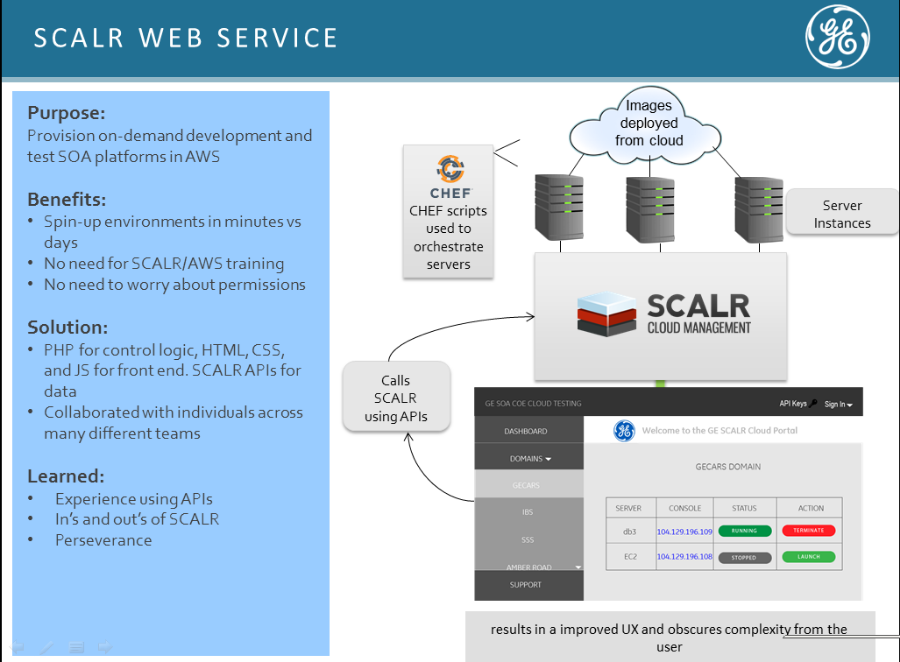PROBLEM:
Since 2013 General Electric has been determined to streamline and simplify its business processes through an initiative called the Enterprise Standards. The team I was assigned to was tasked with deploying the IT integrations for the Enterprise Standards. But without a centralized platform for testing and downloading integrations, the process of deployment could take several days. The preferred method of testing deployments was through a new platform called SCALR, a cloud server management service. While SCALR makes it convenient to control servers, its problem lies in its learning curve and in how grants too much control to an average user. A novice user can accidentally terminate critical servers because the service offers such granular controls.
GOAL:
My task was to make a web service application that would interface with SCALR to download my team’s IT integrations and then monitor server status through links that would be fed to the app via web APIs. The goal of the application was to have as simple of an interface as possible by bypassing the overwhelming amount of controls offered by SCALR and to reduce overall deployment time.
pROCESS:
Customer discovery:
As with any major product it is important to remain aware of what users intend to use your product. The users that I was building this service for were going to be GE teams looking to for a fast method for testing IT integrations with little friction. Therefore, I had to meet these users’ expectations by making sure the app conformed to GE branding and aesthetics.Constraints:
Technical Constraints: Manipulating APIs was a task that I had never undertaken before and I never written a program for public use
Resource Constraints: Being the sole developer behind this project meant that I needed to both develop the programming logic behind the app as well as making the sure the app looked and performed well on the front-end through its visuals and design
Time Constraints: I began working on this project with about 3 weeks left in my internship, which meant there was limited time to design and roll out a minimum viable productSketches and Paper Mock-ups
4. Process Conceptualization:
5. High-fidelity Mock-ups
6. Roll-out of Minimum Viable Product
Takeaways
This project was extremely challenging on multiple levels. Firstly, there were many resource and time constraints that hindered development. Fortunately, many of these obstacles were able to be overcome through heavy collaboration with other GE employees also using these services and with proper project management. I utilized slack as a project management tool to increase transparency between my progress and my collaborators and broke down development into separate phases that each had a tangible deliverable.
Overall, I had a real blast working on the GE SCALR project. I learned a plethora of new technical skills and used a variety of new tools and processes to help complete the project. My autonomy over the project also gave me a lot of project management experience and I was able to collaborate with employees all over the world and produced a product that had a tangible impact in increasing the speed and efficiency of the way people work.
Tools used:
PHP, HTML, CSS, Twitter Bootstrap, XAMPP (Apache Local Host), SCALR CMP, AWS Cloud, XML, Sublime text 2






